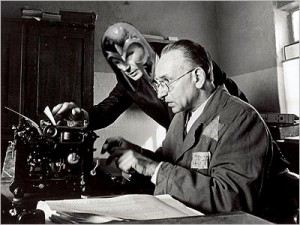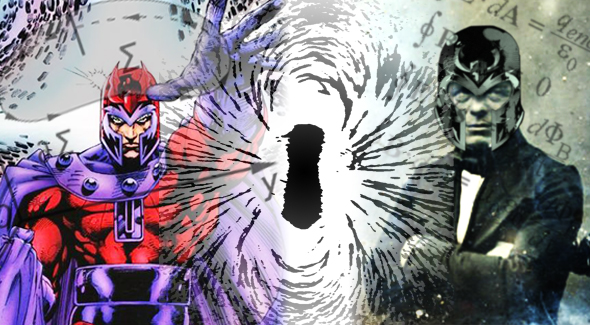Magneto: Where the only limitation… is Yourself!

"Earth's most powerful supervillian!" Take that, StrongNuclear-o.
So, taking into account all that we now know, how can we justify Magneto’s apparently limited scope? It would be easy to explain it non-diegetically, to infer that a character like Magneto is intrinsically limited by the scientific fluency of his writers. However, this kind of thinking relegates our discussion to the realm of literary criticism, and we Overthinkers can hardly tolerate that. No, for the sake of keeping it zesty, let’s keep our arguments firmly diegetic, and assume instead that any limitation on Magneto’s powers be self-consistent with the universe in which he lives.
One explanation that has already been put forth on this site simply curtails Magneto’s abilities. If he is not (as he frequently boasts) the Master of Magnetism, but merely, say, A Dude With His G.E.D. in Magnetism, then that explains it. And yet, I find this kind of argument disappointing. After all, Magneto is the most feared mutant on Earth, the most reviled adversary of the Uncanny X-Men. These characters have encapsulated themes of youth in revolt–against antiquated, entrenched social mores, against the allegorical pubescent confusion surrounding their own forms and abilities–in a way that no comic book characters had done before, and which few have achieved since. To hamstring their most powerful opponent, the man at the center of their most heartbreaking failure, in this manner, hardly seems to do any of the characters justice.

Easy, big fella'.
It’s possible, of course, that Magneto himself doesn’t fully understand the extent of his capabilities. Of note, he spent a large portion of his youth in a Nazi concentration camp, and likely never received any formal scientific education. This seems unlikely to me for three reasons. First, in some regards all mutants’ abilities seem autonomic, i.e. without need for a formal academic understanding. Without training they may manifest in uncontrollable ways, but then so does (for example) our sense of smell. With proper training, one can learn to detect subtle components in a wine’s bouquet, but no one needs to understand the biochemistry of smell just to know that they’re able to detect odor at all. Hence, while it might not be immediately apparent to him why he’s able to “feel” the magnetic moments of hydrogen atoms, Magneto’d probably be able to do it nonetheless. Second, I think the cultural connections to his ancestral people probably emphasized self-education in the sciences, even outside the constraints of formal schooling. Hence, he probably picked the stuff up on his own after the war. Third, and most important, there’s this. It seems unlikely that he’d name himself for a device that uses magnets to generate electricity, without knowing that he’s able to generate electricity.
So why, then, does Erik Lehnsherr find himself limited to the telekinesis of metal objects, the sabotage of electronic devices, and the occasional force-field? To me, the answer is simple:
Brand management.
Magneto understands that his greatest power–even beyond the awesome might of Maxwell’s Laws–is the power he holds in the public consciousness. Consider the way that magnets and electricity are commonly thought of in society, and the way that his power subverts this notion. As small children, we’re taught that the electric outlets in our house are wild, horrifyingly dangerous devices that should be respected from a comfortable distance. We’re rapt in terror by the unbridled power of lightning. And all the while, we learn that magnets can hold our crayon drawings to the refrigerator door (N.B.: not if you slam the magnet on the floor a few times. Then it loses its magnetism.). Even later, we learn to see magnetism as an afterthought of electricity: we can make an electromagnet from a battery and a wire, assuming we’re not building more useful circuits with them.

Fun Trivia Fact: Photoshopping Magneto's Helmet on Anne Frank's head is NEVER. FUNNY.
Magneto is a man who has taken the familiar, the docile, the seemingly meek, and has transformed it into a weapon to be respected and feared. Without stretching the analogy too greatly, one can again see a hint of allegory for the Jewish people: they’re a group also once thought to be docile, seemingly meek, and now (for better or for worse) seen as a brawny, militaristic power that’s–if nothing else–feared.
For Magneto, this fear is most effective when his actions play directly to the audience’s preconceived (somewhat ill-informed) notions. No super villain wants to find himself mid-diatribe, having to explain things. Consider the following:
***
[Ext. the Franklin Mint, day. MAGNETO hovers triumphantly over a group of subdued X-MEN he’s hogtied with steel girders]
MAGNETO: At LAST you puny X-men shall yield to the magnificent might of Magneto: Master of Magnetism! Watch in horror as I raze your precious Humans’ beloved Franklin Mint to its very foundations! From this day forth, NOTHING will ever be guaranteed to increase in value AGAIN!
[MAGNETO lifts his arms towards the Mint’s doors, his concentration fixed, unwavering. His eyes disappear amidst a pale-blue crackle as freakish tendrils of electricity begin to emanate from his fingertips. With thunderous CRAKOWS, lightning bolts begin to stream freely toward the Mint’s metal frame.]
CYCLOPS: Whoa, whoa, whoa! Hold the phone! Since when can you shoot lightning bolts?
JEAN GREY: Yeah, you’re not the “Master of Electricity,” Magneto! Stick to the script!
MAGNETO: Well, actually, the two properties are intrinsically linked, owing to the physical laws of…
BEAST: Who chatters on about physics while holding up the Franklin Mint? That’s just idle justification if I’ve ever heard it.
MAGNETO: Wha? Hank, you of all people… I figured you’d know about the Faraday Effect…
ICEMAN: Faraday Effect? He’s in the Brotherhood of Evil Mutants now?
MAGNETO: No, it’s…
WOLVERINE: I think Faraday Effect’s one of the Morlocks. Also, I’m in the X-men now, for some reason. Hey guys.
OTHER X-MEN: Hey.
MAGNETO: Look, the Faraday Effect is a fundamental law of the universe! It’s not a frackin’ supervillian!
STAN “THE MAN” LEE: Can’t it be both? I mean, Ditko and I’ve done worse…
MAGNETO: (sputters to himself inaudibly)
[THE WATCHER appears, to AUDIBLE GROANS]
THE WATCHER: Perhaps my mystical, all-seeing abilities can shed some light on the matter?
EVERYONE: NOOO!
***
Remember: the goal here is fear, not confusion. And that fear can only remain effective as long as the intended audience understands what they’re supposed to be afraid of. The sad truth is: as long as the public fails to really understand magnetism, Magneto will be forced to play to their ignorance. And in that regard, I guess, he’ll never truly be free.

Magneto should be able to suppress electromagnetic fields as well as create them, right? In that case, wouldn’t he be able to instantly separate water into clouds of hydrogen and oxygen? Or even into, like, a giant cloud of free neutrons and neutrinos?
If Magneto’s powers come from control of the Electromagnetic force, rather than the shape of the atoms of magical mutantiness, wouldn’t that imply that he also has control over Weak Nuclear Force by way of Electroweak unification? If he could control the Weak nuclear smoke, he should just be able to dissolve anything in his way into a puff of dust and radiation, like a bank vault door or any pesky X-men in his way, and the ability to dissolve anything or anyone seems quite scary enough. Marvel Universe: where Weinberg was wrong?
These are excellent questions! Makes me glad I wrote this post.
@Jordan: He should be able to nullify magnetic fields, I guess (or rather, create a magnetic field of equal magnitude but opposite polarity, thereby summing the overall field to zero). But I don’t think that’d let him disintegrate molecules. The bonds between atomic nuclei are indeed formed by electrons, which can be thought of as being in a constant state of motion, but beyond that we get into the world of quantum magnetism, which is quite a bit hairier. Because of Heisenberg, we can’t really think of an electron as a little ball in orbit around a bigger ball (as it’s so often schematized). Or rather, we *can* think of it that way, but wouldn’t be able to know how fast it’s going (and hence, the change in its Electric Field vector). In quantum physics we summarize an electron (or any other quantum system) in terms of a Wave Function, Psi(x,y,z,t), which can be thought of as the square of the probability function. That is, SqrRt(Psi(x,y,z,t)) will give you the probability of having an electron in a given position, (x,y,z) and time, t.
Molecular bonding, then, happens when the electrons inhabiting a given atomic Psi function are moved into a new Psi function centered around each of the atomic nuclei in the bond. The energetics (and hence, allowable bond-forming/breaking functions available to a system) are dictated by Highest Occumpied Molecular Orbital/Lowest Unoccupied Molecular Orbital theory—or the so-called “HOMO/LUMO” model. SO, in order for magneto to disintegrate water into its substituents, he’d have to (A) Have a handle on the probabilistic, quantum magnetic fields generated by the current HOMO in H2O (herher..) and then (B) be able to generate a field that’d swap the energetics of them such that the electrons repopulate atomic orbitals (which are normally higher energy than molecular orbitals). It’s a tall order. To wit, I don’t know of any device that can use magnets to make or break atomic bonds.
Photolysis, on the other hand, should be well within his wheelhouse. There are a number of cases where atomic bonds can be made/broken by addition of light. X-rays, for example, are fantastic at breaking all sorts of bonds nonspecifically, but many bonds will respond to a single wavelength of applied light. One can even photolyse water, for example. But the effects of this weapon would be less specific: I imagine that, once he’s generated powerful enough light to lyse water molecules in your body, you’d probably get severely burned by the effects that light’s having on all your non-water molecules, too.
As for your answer to the neutrino separation, check out my answer to Liza’s question…
@Liza. True, but non at this temperature, right? Electroweak unification-the point where the virtual photons that “exert” the electromagnetic force “merge” with the W and Z bosons of the Weak Force-doesn’t spontaneously happen until you get to ~10^15 K. (In Boston, for example, it’s currently ~307 K, so we’d have a ways to go). Statistical thermodynamics informs us that any allowable transition should be attainable at any temperature, but with different probabilities. I don’t know what the partition function (which allots the allowable energetic states into different probabilities) looks like for electroweak unification at these temps, but I’d hazard a guess that it’s <<< 1 in 10^23 (since, for example, we never observe, like, spontaneous explosions of water molecules in 18 mL of water).
SO, Magneto'd be able to exploit the Weak Nuclear Force, but veeeeeerrry little of it. Caveat: he'd hold more sway in the center of the sun.
Do the same people that lobby for intelligent design textbooks also lobby for the LUMO-only model of molecular dynamics?
Terrific article, I’m sharing it with all my comicky friends. All it takes is for one person to come along and write the story, of course, and then all his powers could at last break loose.
This is incredibly good. One of the best articles I’ve read in a long time. Very well written, very entertaining, very clever. I commend you.
This article is why I love over-thin king it.
I only wish I was knowledgeable enough to say something clever.
Aww… thanks so much, Tim, Archie and Stefan! I always worry that my particular fondness for math might scare away, well, everybody. :)
@Jordan: It only gets worse, sadly. Depending on the energetics and local structures of two molecules’ HOMOs and LUMOs, they can sometimes react by what’s termed an “SN2” mechanism, otherwise called “Backside Attack.”
Yes, that’s right. All across the country, Orgo students are required to answer problem set questions of the form, “…do molecule X and Y’s HOMOs support a backside attack model?” with a straight face.
Now that I think of it, I’m gonna’ start marketing T-shirts to bible-belt chemistry students that read, “God Made Adam and Eve, not Pi and Pi*.”
Perhaps he’s really just lying about his abilities, knowing that if the truth were revealed he’d be farmed for his midichlorians.
I think he’s actually just snapping branes around like a repressed locker-room towel whip.
Insane in the P-brane! Insane in the brane!
Or maybe he has a magic garment. I suspect it’s that nice Casimir turtleneck.
I (or you) could argue that this helps to explain his seeming genius level grasp on every field of science from genetics to particle physics to how mutant powers actually -work-.
I think the limits to his powers are more to do with the limits of the human mind. I propose tehre is a limit to the number of electro magnetic fields he can generate at a time. Lets for the sake of argument agree that that number is 1000. I base that on the maximum number of objects I have seen magneto manipulate at a time in the x-man series. Given this it is best if he focuses his magnetic fiels on objects that have all their atoms aligned with their poles in the same direction. Otherwise he would have to create a new field for each atom. An object made up of only 1000 atoms would be quite small. So he instead focuses on metal objects.
I also don’t think he could change his apearance because that would require a magnetic field orchestrated in an extremely complex shape. A different curve for every change would be needed. He could however make himself disapear with a spherical field diverting light around him.
Again I think the limitations are with his mind and the limits of the human mind. We have no specialized portion of the brain for controlling things that are hyper small and large in quantity. We can barely even comprehend numbers over a million,much less the billions and trillions of fields needed to move non magnetic objects.
The arrangement you’re describing in the “telekinesis of nonmagnetic materials” sounds like antiferromagnetism. Most materials are diamagnetic – that is, the molecules tend to align opposite the magnetic field. Put another way, if you graphed magnetization (the net alignment of the molecules) versus applied field for a diamagnet, it would look like a line in the 2nd and 4th quadrants. As such, it’s quite possible to levitate something that’s not generally considered magnetic in a magnetic field – it just takes a pretty large field.
For example, a frog being levitated: http://www.youtube.com/watch?v=A1vyB-O5i6E
For something of that size, the field required is something on the order of 10 tesla (the Earth’s magnetic field is about 50 microtesla; a typical refrigerator magnet is about 5 millitesla). A large field, sure, and one that probably requires a superconducting magnet, but not incomprehensibly large.
@Howard: If I hadn’t seen the levitating frog (strawberry, grasshopper &ct) with own looking-balls, I’d never have believed it. My understanding must be in err, then: I thought that, in the presence of a large external field, the spin vectors (and hence the resultant magnetic dipole) precess. Which is to say, they orient with a vector component–let’s call it z–parallel (or antiparallel) to the field, but with x and y components varying as the vector sum precesses in the circular path. Perhaps this is only applicable in an NMR experiment, amongst the resonant population? Or, perhaps the spin-vector precession doesn’t change the orientation of the external dipole?
True that a 10 T field isn’t huge; it’s roughly comparable to what a mid-level NMR apparatus uses, right? I haven’t done the calculation, but it should be *way* less than what’s required to lift a submarine out of its depths…
@Foxbat – I’ll concede that keeping a hold on thousands of discrete fields would probably be too much for one
person’smutant’s brain to handle simultaneously. However, controlling things that are hyper small (at least in units of time, which is applicable here) is well within the average person’s reach. Anyone who can whistle or sing is consciously vibrating the air around them at hundreds of intervals per second. Doing so doesn’t require an explicit knowledge of the physics of sound, but is essentially instinctive: their brain’s manipulation of the macroscopic outcome (a discrete pitch) is enough–physics can handle the rest. SO, if we assume that Magneto’s control over his powers is as instinctive to him as whistling is to us, then changing the color, direction, polarization of light should be within his scope.@Everybody: Incidentally, it’s unclear to me why magnetic fields can’t lens light on their own, as large gravitation fields do. This is why I described Magneto’s proposed “invisibility” as stemming from his direct manipulation of the individual light beams’ magnetic components–not just by his applying a large field to himself and letting the light bend around him. Anyone care to explicate? Also, how intense (or how dramatic would the cutoff between “in-field” and “out-field”) would a magnetic field need to be in order to generate a Hawking-radiation-type system? That is, if the “quantum foam” yielded two oppositely charged particles *just* at the cusp of an intense field (an ambiguous term I’m using instead of “event horizon”), one should be sucked into the field, while the other radiates away. Of course, unlike Hawking radiation, each of the particles would survive. Thoughts? This is about the point where the emphasis on the *bio* part of my biophysics training becomes painfully clear…
Individual spins do precess, but they precess around any perpendicular magnetic field. The frequency with which they precess depends on the field strength. My understanding of MRI is that it uses nuclear magnetic resonance, which involves first applying a constant field to align the nuclear spins and then hitting the system with an additional pulsed perpendicular field that varies at a given frequency. When the frequency matches the resonance frequency of a given nucleus, there’s some signature that we can measure (this is where my understanding gets fuzzy). According to wiki, a typical MRI in a hospital uses a 1.5-3 T field, with up to 10 being used in research facilities.
Diamagnetism basically works because the applied field perturbs the electrons orbiting the nucleus, changing the flux through the little current loop of the electron orbit, which brings Lenz’s Law into play. It’s a spin-orbit effect (and I kind of hate invoking that), not a spin alignment effect like other types of magnetism. The levitation works by making a field gradient that opposes gravity. It’s not quite the same arrangement as the MRI.
Magnetic fields don’t do anything to light because photons don’t have charge. Same thing with electric fields – there’s no force exerted on anything that doesn’t have a charge, and photons are just traveling waves. The superposition principle applies for electric/magnetic fields, so fields don’t have any effect on other fields. Gravity doesn’t change the photons themselves, as photons don’t have mass. Gravity distorts the space that light travels through. I guess it’s a somewhat subtle point, but there you go. Imagine a ball rolling on a sheet – you can change the ball’s path both by physically touching the ball and pushing it in some direction, or you can do it by distorting the sheet. Gravity does the latter.
I’m not really sure how Hawking radiation works, so I’m not sure I can give a good answer for that question. Magnetic force only changes the direction of a charged particle’s velocity (the force equation involves a cross product), and since the particles are oppositely charged, they would attract and annihilate. So I suppose the answer is that there is no magnetic field you could apply to keep the particles apart. You could do it with an electric field, which would accelerate the particles in opposite directions, but I have no idea how big it would need to be. Presumably it would be huge, since the particle-antiparticle pair would be generated pretty close to one another, and electromagnetism is a relatively strong force.
Has Magneto ever threatened to stop the Earth’s core rotating thereby
giving everyone sunburnSTOPPING GRAVITY AND EVERYONE FLOATING OFF INTO SPACE!?